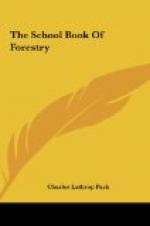We can keep our remaining forests alive and piece out their production over a long period if we practice conservation methods generally throughout the country. Our remaining forests can be lumbered according to the rules of practical forestry without great expense to the owners. In the long run, they will realize much larger returns from handling the woods in this way. This work of saving the forests should begin at once. It should be practiced in every state. Our cut-over and idle lands should be put to work. Our forest lands should be handled just like fertile farming lands that produce big crops. The farmer does not attempt to take all the fertility out of the land in the harvest of one bumper crop. He handles the field so that it will produce profitable crops every season. He fertilizes the soil and tills it so as to add to its productive power. Similarly, our forests should be worked so that they will yield successive crops of lumber year after year.
Lumbermen who own forests from which they desire to harvest a timber crop should first of all survey the woods, or have some experienced forester do this work, to decide on what trees should be cut and the best methods of logging to follow. The trees to be cut should be selected carefully and marked. The owner should determine how best to protect the young and standing timber during lumbering. He should decide on what plantings he will make to replace the trees that are cut. He should survey and estimate the future yield of the forest. He should study the young trees and decide about when they will be ripe to cut and what they will yield. From this information, he can determine his future income from the forest and the best ways of handling the woodlands.
Under present conditions in this country, only those trees should be cut from our forests which are mature and ready for the ax. This means that the harvest must be made under conditions where there are enough young trees to take the place of the full-grown trees that are removed. Cutting is best done during the winter when the trees are dormant. If the cutting is performed during the spring or summer, the bark, twigs and leaves of the surrounding young growth may be seriously damaged by the falling trees. The trees should be cut as low to the ground as is practicable, as high stumps waste valuable timber. Care should be taken so that they will not break or split in falling. Trees should be dropped so that they will not crush young seedlings and sapling growth as they fall. It is no more difficult or costly to throw a tree so that it will not injure young trees than it is to drop it anywhere without regard for the future of the forest.
Directly after cutting, the fallen timber should be trimmed so as to remove branches that are crushing down any young growth or seedling. In some forests the young growth is so thick that it is impossible to throw trees without falling them on some of these baby trees which will spring back into place again if the heavy branches are removed at once. The top of the tree should be trimmed so that it will lie close to the ground. Under such conditions it will rot rapidly and be less of a fire menace. The dry tops of trees which lodge above the ground are most dangerous sources of fire as they burn easily and rapidly.




